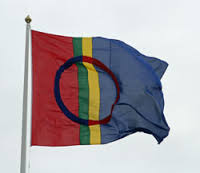There was much honour held this year for International Saami Day, which is celebrated on February 6 when the Saami Congress declared the day in 1992.
For example, in the municipality of Karasjok – the site of Norway’s Saami Parliament – there is a celebration of community every year.
This is not without controversy, though, as some refer to it as Saami’s People’s Day and others as National Saami Day, implying that Sapmi is an Indigenous nation within the state borders of Finland, Sweden, Norway and Russia – essentially encompassing the most North of North regions of these states. Other Saami live in Alaska and areas south in North America.
The Saami were colonized by these states European states as their borders were overrun by settlers.
European settler states often consider the Saami as an ethinic minority as opposed to an Indigenous nationality, and only in the last few decades has the joined Saami community have come into their own as an Indigenous community after realizing their very lives and lifestyle was at risk with climate change.
Teacher May-Britt Hansen Balto said Karasjok is proud to celebrate the day, “I have noticed the term [nation] has already become more accepted among people,” she said. “I also think it’s important that it should be natural for us to use the adopted term.”
Heidi Persdatter Greiner Haaker, the first deputy to the Sami parliament, “ it’s a shame only four of the 22 municipalities in Akershus fly the Sami flag. ‘It has meant so much to us if municipalities managed to buy a Sami flag and let it wave in the wind,’ she said. ‘It makes you feel a little proud to be a Sami.” She said it’s a sign communities regard Sami culture as equally valuable.’”
The Norwegian Broadcasting Corp. (NRK), “contacted several municipalities, which said they didn’t own a Sami flag, the Sami flag they had was too small, or that flying the Norwegian flag is for everyone in Norway.”
This controversy aside, the Saami across the globe celebrate this date.
One Saami woman living within the borders of Sweden chose to use the day to bring attention to how climate change is negatively affecting the Arctic and the peoples living there.
Mimie Märak in a performance art and protest piece cut off her hair to show her grief over how we mistreat our “eanan” (Mother Earth) and to show the world that the Saami are Idle No More.
You can watch her performance here through the 350.org Facebook page here.
Described by Pacific Saami (PSS) member and Pacific Lutheran University Professor, Troy Storfjell, “The Saami are the Indigenous people of northern Norway, Sweden, Finland and the Kola Peninsula of Russia, sometimes referred to as ‘Lapps’ or ‘Laplanders.’ There are nine Saami languages. Saami participated in the co-founding of the World Council of Indigenous Peoples in the 1970s, and participate in a number of global Indigenous forums and organizations today.”
The Saami community in North America and Europe have been active in Idle No More struggles ever since the Indigenous-led movement went global from its humble roots in Canada.
Other actions in the same vein have been led against British mining company Beowulf and its Swedish counterpart Jokkmokk Iron Mines AB to protect the Gállok region in Sapmi – an area of huge cultural importance to the indigenous reindeer herding communities Sirges and Jåhkågasska, situated close to Jåhkkåmåhke on Lule Saami lands.
For more information on the Saami, please see this video created by the Saami Council for the United Nations.
To join the Facebook group where the Saami support Idle No More in North America, please click this link.



